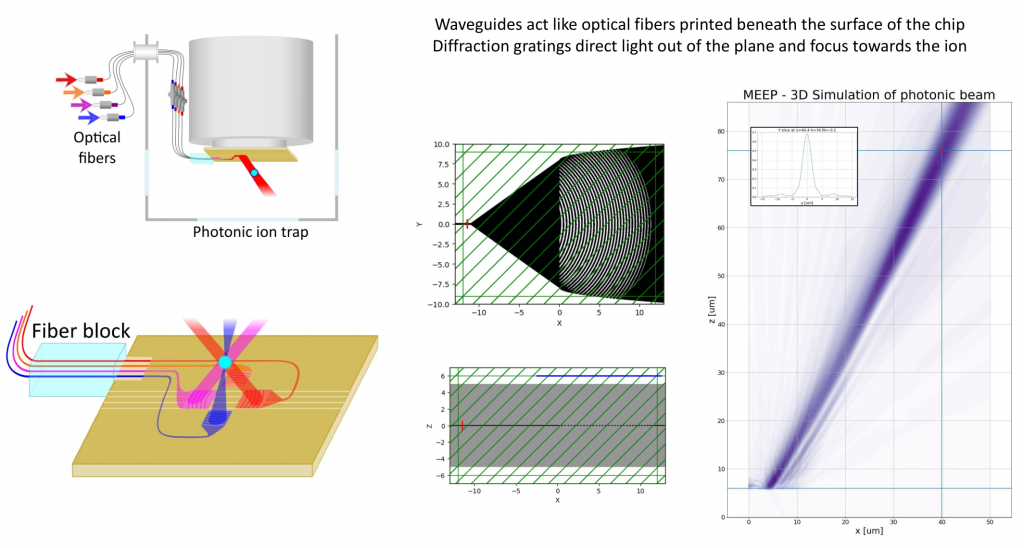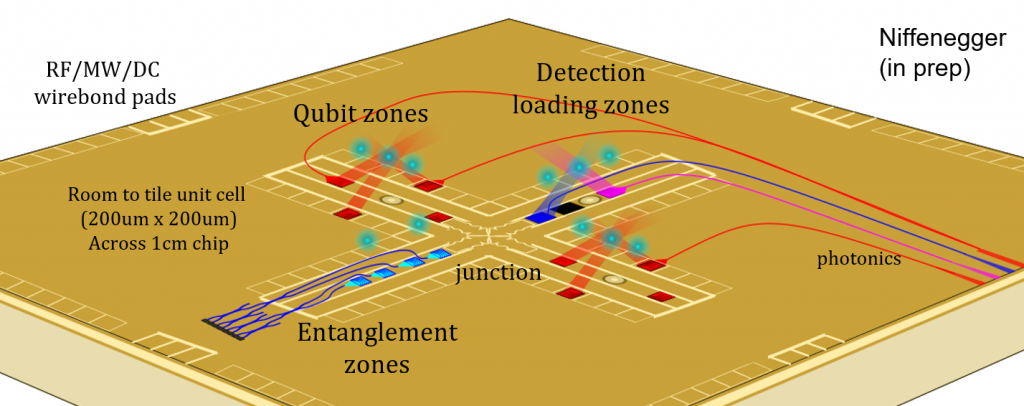The UMass+ Trapped Ion Quantum Computing Lab is developing integrated technologies such as integrated photonics for trapped ion quantum information processors (QIPs).

Recently we’ve investigated using integrated photonic laser sources to perform trapped ion optical clock operations, without bulky and sensitive optical cavities. This could enable monolithic integration of the optical sources within the ion trap chip and enable portable operation of trapped ion optical clocks and trapped ion quantum computers.

Ion Trap Fabrication
At UMass Amherst we design, simulate, fabricate, dice, wirebond, package and test surface electrode ion traps.


Photonics
We design, simulate and test integrated photonics such as waveguides and grating couplers with low loss down to ultraviolet wavelengths (<400nm). These high energy wavelengths are necessary to address optical transitions needed to control trapped ion qubits. We are working to improve the quality of photonic beam profiles to reduce cross talk between neighboring trapped ions and lowering total losses by improving film quality and input coupling designs.

One of the main obstacles for large scale and fault tolerant quantum computation with trapped ion qubits is the difficulty of individually addressing multiple ions using external optical lenses. Integrated photonics may light the way towards large scale quantum computers and practical applications.
We are currently partnering with MITLL to fabricate photonic chips based on their mature ion trap with integrated photonics fabrication process, utilizing their unique capability to use optical lithography to define the fine features of the photonic gratings.

Trapped Ions QIP development
We are setting up a cryogenic vacuum chamber to test our fabricated trapped ion QIP chips. Cooling the chip improves qubit performance by reducing anomalous heating. Cryogenic cooling also allows us to achieve ultra high vacuum pressures in less than a day which enables rapid iteration of trap chips to test new materials/processing and trap designs/layouts.

Monolithic Electronics and Detectors
Integrating the control electronics for trapped ions will be critical as the number of ion qubits increases. Even a single zone of operation can require over ten independent electrodes with stringent noise and bandwidth tradeoffs. Independent qubit readout will also become prohibitive using external detectors as the number of qubits grows. Integrating detectors directly into the trapped ion QIP may not only enable scalable qubit readout but also improve readout times and fidelity due to the proximity to the ions which enables the capture of more photons.
Integrated photonic remote entanglement generation
Remote entanglement generation may be the key towards networking many QIPs and scaling up quantum computers. However, it is a slow process limited by multiple loss channels with bulk optical lenses, beam splitters and detectors. Integrating the collection of light used for remote entanglement generation by using input photonic grating couplers as well as integrating the interference with photonic Mach-Zehnder interferometers could improve entanglement rates and enable multiplexing due to the scalability of the integrated photonics.
